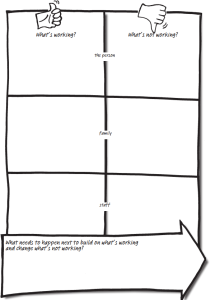Chapter 5: Working / Not Working
The Working / Not Working Tool is a great way to analyze what is happening in someone’s life from more than one perspective. When completing the tool, there is room for the perspective of family, friends, support workers, and, above all, the focus person!
The tool can focus on one area of a person’s life or in general. For example, it can focus on life at school or work life. It can have a focus on where a person lives or even where a person goes for recreational activities. 
Watch a video from Michael Smull about the Working / Not Working tool. During the video, Michael also talks about the 4+1 tool. We will learn about that one later!
Download Working and not working – Transcript Word Doc [15.1KB]
The working / not working tool can be used in various settings and with various groups. Here are some ideas:
1. Use the tool to help make a decision about team duties. Allowing each team member, regardless of their title, to share what they feel is currently working or not working allows everyone to share their point of view.
2. Use the tool to help determine the best housing for a person. By looking at their current living environment, the person and everyone who supports them can outline what is working and not working. When planning new housing, the planner can be sure to keep what was working and address what wasn’t working.
3. Use the tool to help figure out the best job for a person. By looking at what is working well in their current job, we can help identify other jobs the person may be well suited for. By looking at what is not working in their current job, we can help remove jobs or settings from the list of possibilities.
These are just some situations. Answer the following question.
![]()
Knowledge Debrief
Please complete the 3 questions in the quiz question set.
![]()
Person Centered Plan Task
1. Discuss with your focus person what area of life they want to use the Working / Not Working tool with (example: work, recreation, school, home life, job, health and safety, diet, etc.) Note: if the focus person cannot participate due to cognitive level, you must include at least 1 person who knows the person very well.
2. Ask the focus person if there are other perspectives that should be considered. If so, include the others in your discussions (example: spouse or partner, parent, child, co-worker, friend, etc.)
3. Record the input of what is working / not working on a chart.
4. Ask these questions: a) From the “What’s working” list celebrate those things that are working really well. Is there anything you or others need to do to keep what is working happening? b) From your “What’s not working” list, is there anything that you or others could do to change what is not working for you? c) If others gave their perspectives on what is working and not working, are there any differences that you want to talk to them about and see if there is a way forward if there is disagreement?
5. Review Friday Knights Working / Not Working Chart example below. Note: As Friday Knight has significant challenges communicating his desires, the person who knows him best has completed these Person Centered Tools.

What’s Working / Not Working Questions to Consider
a) From the “What’s working” list, celebrate those things that are working really well. Is there anything you or others need to do to keep what is working happening?
- Find a groomer on Manitoulin, so it is easier to book my appointments with Mom’s work schedule.
b) From your “What’s not working” list, is there anything that you or others could do to change what is not working for you?
- Find a way to keep my teeth clean that doesn’t involve brushing them.
- Help me cope with noises in the environment, so I am not so anxious.
c) If others gave their perspectives on what is working and not working, are there any differences that you want to talk to them about and see if there is a way forward if there is disagreement?
N/A
NOTES FOR ACTIONS:
- Investigate other ways to keep a dog’s teeth clean instead of brushing.
- Try the new groomers on the island to see if I like them as much as I like my Sudbury Groomer.

